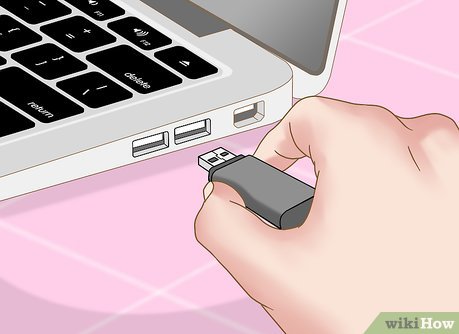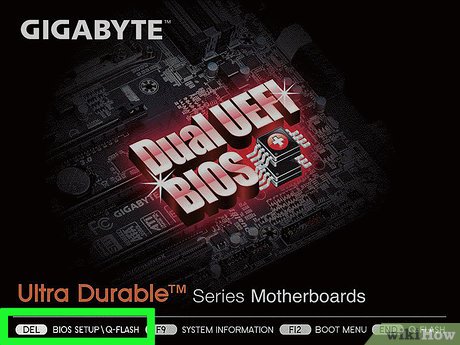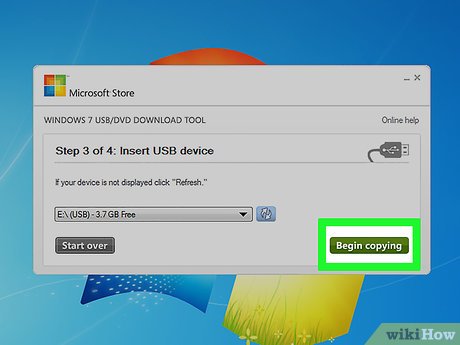How to Boot from USB in Windows 7
Part 1 of 4:
Preparing to Boot
-
 Understand how booting from a USB works. By default, your computer starts up by reading the operating system information from its built-in hard drive. You can change this by telling it to prioritize plugged-in USB items over the built-in hard drive.
Understand how booting from a USB works. By default, your computer starts up by reading the operating system information from its built-in hard drive. You can change this by telling it to prioritize plugged-in USB items over the built-in hard drive.- The settings for your computers boot behavior are in a menu called the BIOS, which is a pre-startup menu you can access by pressing a key specific to your computer model as your computer turns on.
- In order to boot from a USB flash drive, the flash drive must be set up as a bootable item, and it must have a disk image (ISO) file with an operating system or similar service installed on it.
-
 Determine your computer's BIOS key. The key that you press to access the BIOS varies depending on your computer manufacturer and model. You can look up your computer's BIOS key by typing your computer's manufacturer and model name, along with "bios key", into a search engine and reviewing the results, or you can consult your computer's manual if you still have it.
Determine your computer's BIOS key. The key that you press to access the BIOS varies depending on your computer manufacturer and model. You can look up your computer's BIOS key by typing your computer's manufacturer and model name, along with "bios key", into a search engine and reviewing the results, or you can consult your computer's manual if you still have it.- Most computers use one of the function keys (e.g., F12) as the BIOS key, though some computers will use the Esc key or the Del key.
-
 Plug your USB flash drive into your computer. The USB flash drive should plug into one of the rectangular USB ports on your computer's housing.
Plug your USB flash drive into your computer. The USB flash drive should plug into one of the rectangular USB ports on your computer's housing.- On a laptop, the USB ports are typically on the sides of the housing, while desktop computers typically have the USB ports on the front or back of the tower.
-
 Make the USB flash drive bootable. If your flash drive isn't already bootable, use the Command Prompt or one of the Windows installation tools to make it so.
Make the USB flash drive bootable. If your flash drive isn't already bootable, use the Command Prompt or one of the Windows installation tools to make it so. -
 Add the file to which you want to boot to the flash drive. Copy the ISO file you want to boot from by clicking it once and then pressing Ctrl+C, then open your flash drive and press Ctrl+V to paste in the file.
Add the file to which you want to boot to the flash drive. Copy the ISO file you want to boot from by clicking it once and then pressing Ctrl+C, then open your flash drive and press Ctrl+V to paste in the file.- For example, if you're attempting to install or use Ubuntu Linux from the flash drive, you would paste the Ubuntu ISO file into the flash drive's window.
- Skip this step if you created a bootable USB using the Windows 7 or 10 installation tool.
-
 Save and close any open work. Before you proceed with accessing the BIOS, you'll want to save any open work and then close any open programs to avoid losing your progress.
Save and close any open work. Before you proceed with accessing the BIOS, you'll want to save any open work and then close any open programs to avoid losing your progress.
Part 2 of 4:
Accessing the BIOS
-
 Open Start. Click the multicolored Windows logo in the bottom-left corner of the screen.
Open Start. Click the multicolored Windows logo in the bottom-left corner of the screen.
-
 Click Shut down. It's on the right side of the Start menu. Doing so will prompt the computer to begin shutting down.
Click Shut down. It's on the right side of the Start menu. Doing so will prompt the computer to begin shutting down.- You may have to confirm this decision.
-
 Wait for your computer to finish shutting down. Once your computer falls completely silent, you can proceed.
Wait for your computer to finish shutting down. Once your computer falls completely silent, you can proceed. -
 Press your computer's Power button. Your computer will begin to start up.
Press your computer's Power button. Your computer will begin to start up.
-
 Immediately begin tapping the BIOS key. You'll want to do this as soon as you release the Power button, and don't stop until the BIOS screen appears.
Immediately begin tapping the BIOS key. You'll want to do this as soon as you release the Power button, and don't stop until the BIOS screen appears. -
 Stop pressing the BIOS key when the BIOS page loads. The BIOS page usually resembles a blue screen with white letters, though your BIOS may look different. At this point, you're free to change your computer's boot order.
Stop pressing the BIOS key when the BIOS page loads. The BIOS page usually resembles a blue screen with white letters, though your BIOS may look different. At this point, you're free to change your computer's boot order.
Part 3 of 4:
Changing Boot Order
-
 Find the "Boot Order" section. You may see this option on the main BIOS screen, but you'll most likely have to scroll left or right (using the left and right arrow keys, respectively) through the tabs at the top of the screen until you find the "Boot Order" section.
Find the "Boot Order" section. You may see this option on the main BIOS screen, but you'll most likely have to scroll left or right (using the left and right arrow keys, respectively) through the tabs at the top of the screen until you find the "Boot Order" section.- You'll probably find this section on the Advanced tab, though many BIOS variations have dedicated Boot Order tabs as well.
-
 Open the "Boot Order" menu. If the "Boot Order" section is a menu item instead of a heading, select it by using the arrow keys and then press ↵ Enter.
Open the "Boot Order" menu. If the "Boot Order" section is a menu item instead of a heading, select it by using the arrow keys and then press ↵ Enter. -
 Select the "USB" option. Find and scroll down to the "USB" option in the list of boot locations.
Select the "USB" option. Find and scroll down to the "USB" option in the list of boot locations. -
 Look for the key legend. You'll usually find this in the lower-right side of the screen, though it may be at the bottom of the screen instead.
Look for the key legend. You'll usually find this in the lower-right side of the screen, though it may be at the bottom of the screen instead. -
 Determine which key to use to move up the selected option. Usually you'll press the + key to move up the selected option, but check the key legend's information to be sure.
Determine which key to use to move up the selected option. Usually you'll press the + key to move up the selected option, but check the key legend's information to be sure. -
 Move the "USB" option to the top of the list. Press the proper key until the selected "USB" option is at the top of the "Boot Order" list. This ensures that, when you boot up your computer again, your computer will look for a bootable USB option instead of defaulting to the hard drive.
Move the "USB" option to the top of the list. Press the proper key until the selected "USB" option is at the top of the "Boot Order" list. This ensures that, when you boot up your computer again, your computer will look for a bootable USB option instead of defaulting to the hard drive.
Part 4 of 4:
Booting from USB
-
 Save your changes and exit the BIOS. Press the "Save and Exit" key as specified by the key legend, then press the "Confirm" key when prompted.
Save your changes and exit the BIOS. Press the "Save and Exit" key as specified by the key legend, then press the "Confirm" key when prompted.- For example, you might press Esc to save your changes and then press Y to confirm that you want to save and exit.
-
 Restart your computer if necessary. If your computer doesn't boot from the USB flash drive the first time, it might have already selected your hard drive as the boot location. If so, you'll need to restart your computer (with the USB flash drive plugged in) before proceeding.
Restart your computer if necessary. If your computer doesn't boot from the USB flash drive the first time, it might have already selected your hard drive as the boot location. If so, you'll need to restart your computer (with the USB flash drive plugged in) before proceeding. -
 Wait for your USB program's menu to appear. Once your computer recognizes the USB flash drive as a bootable location, you should see the USB flash drive's installed program, service, or menu appear.
Wait for your USB program's menu to appear. Once your computer recognizes the USB flash drive as a bootable location, you should see the USB flash drive's installed program, service, or menu appear. -
 Follow any on-screen instructions. When the menu appears, you can proceed with running and/or installing your USB flash drive's program or service.
Follow any on-screen instructions. When the menu appears, you can proceed with running and/or installing your USB flash drive's program or service.
5 ★ | 2 Vote
You should read it
- How much C computer drive capacity to be reasonable?
- Notes when buying a computer hard drive
- How to identify hard drive failure, hard drive failure, bad hard drive on Windows
- 5 hard drives with the best reliability
- How to Unmount a Drive
- How to Format an SSD Drive
- How to Transfer Data from a Flash Drive to a Computer
- Remove the USB drive when the computer is in sleep mode (Sleep) is it safe?
May be interested
- How to Fix Boot Loop Problems in Windows
 after starting your windows device, you may sometimes experience an infinite boot loop issue (also known as an 'infinite boot loop' error).
after starting your windows device, you may sometimes experience an infinite boot loop issue (also known as an 'infinite boot loop' error). - Use parallel Windows 7 and Windows 8 on PC
 if you have a pc running windows 7 but aren't sure if you're ready to upgrade to windows 8, a dual-boot system might be a good solution.
if you have a pc running windows 7 but aren't sure if you're ready to upgrade to windows 8, a dual-boot system might be a good solution. - How does Windows 10 start up?
 when you press the pc power button, the windows 10 boot process starts taking place in a certain sequence.
when you press the pc power button, the windows 10 boot process starts taking place in a certain sequence. - DLC Boot - Download DLC Boot here
 dlc boot is a troubleshooting utility that allows users to find and fix problems present in the pc. the application includes various tools that help determine the status of software and hardware installed on a desktop or laptop computer.
dlc boot is a troubleshooting utility that allows users to find and fix problems present in the pc. the application includes various tools that help determine the status of software and hardware installed on a desktop or laptop computer. - What is Boot Sector?
 boot sector is a physical area, or part of a hard drive, that includes information on how to start the boot process to load an operating system.
boot sector is a physical area, or part of a hard drive, that includes information on how to start the boot process to load an operating system. - How to create USB boot versatile, USB rescue by DLC Boot
 to create usb boot, usb rescue we can use dlc boot software with the ability to fix windows errors, data, drive division, computer partition, ...
to create usb boot, usb rescue we can use dlc boot software with the ability to fix windows errors, data, drive division, computer partition, ... - How to check Secure Boot has been enabled on your computer or not?
 on windows 8 and windows 10 versions, microsoft integrates on a feature system called secure boot, and by default this feature has been activated. the secure boot feature supports security on your system but in some cases you will have to disable this feature to run older versions of windows or linux versions.
on windows 8 and windows 10 versions, microsoft integrates on a feature system called secure boot, and by default this feature has been activated. the secure boot feature supports security on your system but in some cases you will have to disable this feature to run older versions of windows or linux versions. - How to fix, fix slow boot computer, Windows 10 boot slowly
 since its launch, windows 10 has affirmed its outstanding advantages. however, after a period of use, you may feel your computer boots slower than before. if you are confident that your computer configuration fully meets the requirements of windows 10, then try to fix the slow boot computer with the following actions
since its launch, windows 10 has affirmed its outstanding advantages. however, after a period of use, you may feel your computer boots slower than before. if you are confident that your computer configuration fully meets the requirements of windows 10, then try to fix the slow boot computer with the following actions - 2 ways to fix the error can not boot into Windows
 2 ways to help you fix the error that cannot boot to win effectively. computer boot up error due to corrupt winload.exe file, please refer to the following article
2 ways to help you fix the error that cannot boot to win effectively. computer boot up error due to corrupt winload.exe file, please refer to the following article - Some tips to speed up Windows 8 boot process
 i can't help but admit that windows 8 has an impressive boot time! however, over time, software applications and a number of system customizations will make the boot time greatly affected, namely windows 8 will take longer to boot.
i can't help but admit that windows 8 has an impressive boot time! however, over time, software applications and a number of system customizations will make the boot time greatly affected, namely windows 8 will take longer to boot.


































 How to Update Your Video Card Drivers on Windows 7
How to Update Your Video Card Drivers on Windows 7 How to Change Startup Programs in Windows 7
How to Change Startup Programs in Windows 7 How to Change File Permissions on Windows 7
How to Change File Permissions on Windows 7 How to Install Windows 7 Using Pen Drive
How to Install Windows 7 Using Pen Drive How to Print Screen on Windows 7
How to Print Screen on Windows 7 How to Activate Windows 7
How to Activate Windows 7